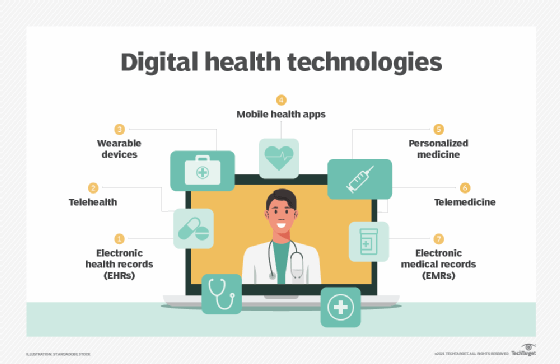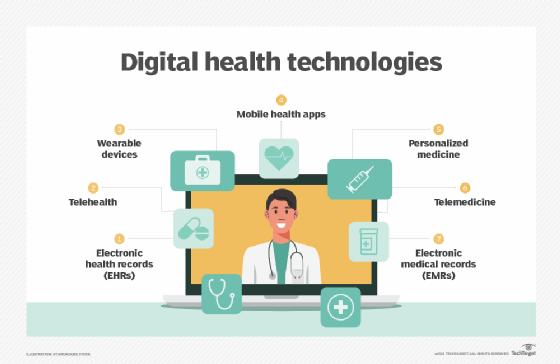
The internet of medical things (IoMT) is the collection of medical devices and applications that connect to healthcare IT systems through online computer networks. IoMT improves patient monitoring and care processes while also increasing operational efficiency and reducing costs.
In practice, IoMT in healthcare can include the following:
- Using remote patient monitoring (RPM) for people with chronic diseases and long-term conditions.
- Tracking patient medication orders.
- Tracking the location of patients admitted to hospitals.
- Collecting data from patients’ wearable mobile health devices.
- Connecting ambulances en route to medical facilities with healthcare professionals.

Medical devices equipped with Wi-Fi enable machine-to-machine communication, which is the basis of IoMT. IoMT devices also link to cloud platforms, where captured data is stored and analyzed. IoMT is also known as the healthcare internet of things (IoT).
The practice of using IoMT devices to monitor patients remotely in their homes is also referred to as telemedicine. This treatment spares patients from having to travel to a hospital or physician’s office whenever they have a medical question or change in their condition.
How does IoMT affect healthcare?
IoMT increases the amount of health data available to caregivers, the variety of sources it comes from and the speed at which it is collected, transmitted and analyzed. More transmitted data improves both patients’ and providers’ decision-making capabilities.
IoMT provides the devices and networks that enable telemedicine and virtual care. Remote healthcare capabilities became popular during the height of the COVID-19 pandemic to limit the number of patients traveling to healthcare facilities and to alleviate the stress on overburdened hospitals and other medical facilities.
Telemedicine makes it easier for people living outside of cities in more remote areas to get access to medical care in general. It also makes it easier for people everywhere to get access to specialists whom they might otherwise not be able to see.
What are the benefits of IoMT?
As part of the broader telemedicine infrastructure, IoMT offers the following advantages:
- Patient monitoring systems. IoMT enables round-the-clock health monitoring of patients with chronic conditions. It also gives healthcare providers better information about the patient’s living circumstances, which can influence care.
- Accessibility. IoMT gives patients more access to health services and education. Patients have more service options and can access them when needed through a telehealth application.
- Cost control. RPM and telehealth save some of the costs of having a patient visit a healthcare facility in person. Faster health data processing also saves providers’ time and money, enabling them to redirect resources to areas that most need their attention.
- Improved patient experience. IoMT enables the use of new technology that facilitates patient self-service and minimizes the need for in-person visits. Consumer-grade wearables give patients access to data that they might traditionally have had to get from a doctor.
- Accuracy. IoMT provides more data, giving medical clinicians more accurate insights into the health conditions of patients. For example, an IoMT-enabled blood pressure monitor can provide several days of blood pressure and heart rate readings that yield a more accurate diagnosis than data from a single doctor’s visit.
- Logistics. IoMT devices monitor equipment in healthcare facilities and send alerts when maintenance and other issues arise. They are also used as trackers to follow patients and medication throughout medical facilities’ campuses, leading to fewer mix-ups and mistakes.
What are the challenges of IoMT?
IoT technology in the healthcare industry and medical settings also raises several issues, including the following:
- Implementation. Interoperability and device compliance with industry standards complicate the implementation of IoMT infrastructure.
- Upfront costs. The initial implementation cost of IoMT technology can be high, and it might take time to get a positive return on investment.
- Security. Protected health information faces more security risks and security regulations, such as the Health Insurance Portability and Accountability Act. Transmitted medical data exposes providers to a range of cybersecurity threats, including data breaches and fraud. Attackers can use stolen credentials to obtain medical services or drugs. Providers face serious compliance penalties and fines in the event of a data breach.
- Data ownership. When IoMT data is generated, it is not always clear to whom it belongs. The patient, software provider and other healthcare providers might generate or touch the data during its lifecycle. Depending on the context, the data rights for each party can be complex.
- Data classification. As technology evolves and IoMT collects a larger variety of data, what constitutes medical data might become harder to define. For example, emergent medical data is health information inferred by AI applications from non-health-related data. AI technology can look at traces left by consumers and other data and turn it into medical data. Monitoring a user’s location is nonmedical information that can be used to track the spread of infectious disease.
- User experience. Designing medical devices and applications that are easy for patients to use can be challenging. Poorly designed devices can lead to limited or flawed data collection when patients remove them or use them incorrectly.
Types of IoMT devices
There are many types of IoMT devices. They are often categorized based on their environment.
In-home IoMT
These devices, which include the following, are used in or placed around a patient’s home:
- Personal emergency response systems. These devices alert a hospital when a patient experiences an emergency.
- RPM devices. These devices collect medical data through continual or scheduled monitoring of patients with chronic conditions.
Wearable IoMT
These devices are also known as on-body IoMT. They are connected to a person’s body and record medical information about them. Wearable devices can be consumer- or medical-grade and include the following:
- Consumer-grade wearables. These on-body IoMT devices include smartwatches that record health data, such as a person’s heart rate and blood pressure. Consumer-grade smart devices can be used without medical supervision for wellness and tracking health metrics.
- Medical-grade wearables. These wearables are used with the supervision of a doctor. For example, a neuromodulation device can manipulate a patient’s nervous system to mitigate pain. Smart pills are ingestible sensors that read information from inside the patient’s body.
Mobile IoMT
These are mobile devices equipped to interface with medical tools and include the following:
- Cellphones. Smartphones that use near-field communication and radio frequency identification (RFID) tags enable devices to share information with other IT systems. For example, patients can control networked glucose monitors on their mobile phones, and medical personnel can access data from their organization’s network.
- Bluetooth-enabled devices. Bluetooth-enabled health devices, such as digital thermometers, can record an individual’s health data and forward it to a smartphone. Other devices include smart inhalers and some telehealth kits.
Public IoMT
Also called community IoMT, these devices are dispersed throughout a geographic area and include the following:
- Point-of-care kiosks. These dispense medical supplies and connect patients with care providers. They give patients in remote areas without traditional medical facilities access to healthcare and healthcare systems.
- Environmental health sensors. These are devices that measure environmental factors that can affect public health, such as air quality, temperature, humidity and water quality. Examples include some heating, ventilation and air conditioning systems as well as urban air quality networks.
In-hospital IoMT
Hospitals use devices with internet connectivity to facilitate patient care. The following are some examples of in-hospital IoMT devices:
- Infusion pumps. These devices, which are often connected to hospital beds, are integrated with analytics dashboards and sensors that measure patients’ vital signs. Hospitals also use IoMT devices for asset and inventory management.
- RFID tags. These are tags that are placed on medical equipment and supplies that send updates to hospital staff on the quantities of items in stock and where they are located. Similar devices are also used to track patients moving through facilities.
What is the difference between IoMT and IoT?
IoT refers to a network of devices that communicate autonomously over that network. They gather data using sensors and route it to other parts of the network without human intervention.
Examples of IoT devices include the following:
- Location and motion detectors on smartphones that communicate with surrounding devices.
- Smart thermostats that measure and regulate temperature in a building.
- Smart home devices, such as smart sensors and motion detection devices.
- Moisture sensors that farmers use to direct irrigation to crops in most need.
IoMT devices are a type of IoT technology that enables medical devices to communicate autonomously over a network. Patient data is collected and transmitted to healthcare providers across IoMT networks, with limited or no direction from the patient or medical professional.
What is the future of IoMT?
The COVID-19 pandemic accelerated the adoption and use of telehealth and related technologies and practices, including the use of IoMT devices. This increased adoption was, in part, due to in‑person care posing an increased risk of infection and lockdowns that limited clinic access. Telehealth and IoMT devices bridged the gap, providing a way for individuals to maintain their health during the pandemic. Since then, the number of connected medical devices continues to grow.
As IoT technology advances, providers will integrate those upgrades into IoMT devices and networks. For example, sensor technology is expected to advance to provide more and better real-time data. At the same time, as AI and machine learning technologies improve, AI-enabled data analytics and machine learning will likely improve predictive healthcare.
One large concern about the use of AI is its lack of clarity in how it makes certain decisions, which is especially important in areas where an individual’s health is in question. As responsible AI and explainable AI systems continue to improve, it will likewise be important for their adoption in the IoMT field.
IoMT-generated healthcare data will also enable more and better research, creating opportunities for new treatments. IoMT devices also have the potential to simplify medical management, decrease costs and improve data sharing and collaboration among healthcare organizations.
There are numerous IoMT devices available to healthcare professionals. Read the following tips about these devices for healthcare IT departments.


